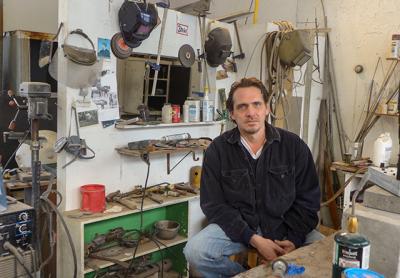Paul Pavia's Small Sculptures Recall Great Monoliths

The sculptor Paul Pavia grew up surrounded by art. His father, Philip Pavia, was a sculptor, and his mother, Natalie Edgar, is a painter. Starting in 1986 when he was 15 years old, their son spent 12 summers in Pietrasanta, Italy, a Tuscan town that has drawn artists for centuries to its marble studios and foundries. He learned figurative sculpture and helped his father, who taught carving there. He also earned a three-month internship at the Peggy Guggenheim Collection in Venice, after which he enrolled in the State University at Binghamton.
“By the time I went to college I didn’t want to study art anymore,” Mr. Pavia said during a recent visit to his Springs studio. “I had had too much of it, and I didn’t want to waste the tuition studying something I already knew. I wanted to try something different, so I majored in philosophy.”
While he didn’t opt for a B.F.A., he did become a teaching assistant in a sculpture class and spent a lot of time in the studio. “They had a great facility. They even had a foundry, which is pretty serious hardware. I learned how to weld there. I didn’t like mold-making and casting because there are too many processes, but I liked welding because it was immediate, and if I messed up, I could fix it.”
The two strains — the assembly of pieces of material into objects and philosophy, especially existentialism — have informed his work ever since. On the material side, he abandoned steel for bronze early on. “Steel rusts,” he said. “You have to use a blowtorch to cut it, and eventually it’s going to decay. I liked bronze because you could patina it. The change was around 2000. I had a job in the city so I could afford to buy bronze, which was cheap then.”
He would cut up the bronze plates, which came in 3-by-4-foot or 3-by-8-foot sheets, put the pieces together, and treat the surface with acid to create different patinas. “I never met anybody who actually cut it up and used it as a collage element,” he said.
As bronze became more expensive, Mr. Pavia began to explore other materials, including wood.
“I used to make fun of woodworkers, but I had a whole surplus of Honduras mahogany, so I figured I might as well use it. Eventually it brought something else to my work, and I began to mix some metal with the wood.” The body of his work shows a feel for materials — in addition to wood, he works mostly with marble, stainless steel, and bronze — and for putting them together.
Most of his pieces are small in size. “My dad believed in big stuff. That’s the difference between him and me. Actually, I like large work too, but I just can’t afford it.” However, his pieces have an intrinsic scale that belies their size.
“I pattern my work on the enormous sculptures and symbols of the past —Stonehenge, Olmec heads, Easter Island,” and other monoliths. “But because I can’t always work in large size, I use space, volume, and scale to compensate. I want to establish a vast, enigmatic landscape that expands from the sculpture. The simple, geometric monoliths have the illusion of being solitary and alive.” He also feels a connection to the static piazzas in some of de Chirico’s paintings, “where time is sort of halted.”
As for the role of existentialism in his work, “I became fascinated with the mind’s sense of self and its relationship to the fleeting, material world. Philosophical writings often describe this state of mind as isolating amid a daunting world. I personally have dealt with these feelings at one time or another, and my sculpture has reflected them, from college to the present. I want it to express mystery and uncertainty.”
Mr. Pavia’s house sits on a wooded lot on Squaw Road in Springs, but it didn’t always. It was originally built in Southold as a summer residence for the Pavia family. “Then they bought the land here,” he said, “and instead of building a house on this property, they moved it over by barge from the North Fork. It says something about our family. We’re a little bit eccentric.”
In 1979, when Paul was 8, he, his brother, Luigi, and his mother moved from New York City to the Springs house, where his father joined them on weekends. “It was around the time that Etan Patz was kidnapped. He wasn’t at my elementary school but at the one next to it, so my mom got scared about our safety.”
Mr. Pavia, who attended the Springs School and East Hampton High School, liked growing up in East Hampton. “I rode my BMX bike and my motocross through the woods, made some friends, and didn’t mind living here. Now I feel like such a foreigner in the city. It’s all coffee shops and Chase banks and condos shooting up all over the place.”
He lives alone, shuttling between the house and the former garage that serves as his equipment-filled studio and a storage space for his work. “January and February can be a little difficult here. But I’m not really a social person. I just want to be in my studio, where I can weld and do the things I do. It’s a little bit like ‘Notes From the Underground’ here.”
Below, “Number Five,” 2013, welded bronze.
